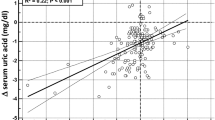Abstract
Although the normal thyroid gland secretes both levothyroxine (L-T4) and levotriiodothyronine (L-T3), normalization of serum TSH with LT4-replacement therapy alone in hypothyroidism is generally believed to result in a normal serum L-T3 and to reflect a euthyroid state. However several recent studies suggest that this may not be the case,. Accordingly, the relationship between serum free L-T4 and free L-T3 was examined in 20 normal individuals (group A) and in 53 patients with chronic autoimmune thyroiditis, 18 with normal TSH on no L-T4-replacement (group B), and 35 with normal TSH on L-T4-replacement therapy for hypothyroidism (group C). Data were analyzed by applying a one-way analysis of variance with correction for multiple comparisons. Serum TSH values were very similar among the 3 groups. In groups A and B, mean serum free T4 and free T3 were very similar. In group C, the mean free T4 (16±2 pmol/l) was significantly higher than the values in groups A (14±1) and B (14±2) (p<0.001) and the mean free T3 lower (4.0±0.5 pmol/l vs 4.2±0.5, NS and 4.4±0.5, p<0.02). Consequently, the mean molar ratio of free T4 to free T3 was significantly higher in group C than the ratios in groups A and B (p<0.0001), despite very similar TSH values. These findings indicate that in hypothyroid patients L-T4-replacement, that is sufficient to maintain a normal serum TSH, is accompanied by a serum free T4 that is higher than that in untreated euthyroid patients or normal individuals and may not result in an appropriately normal serum free T3 concentration.
Similar content being viewed by others
References
Fish L.H., Schwartz H.L., Cavanaugh J., Steffes M.W., Bantle J.P., Oppenheimer J.H. Replacement dose, metabolism, and bioavailability of levothyroxine in the treatment of hypothyroidism. N. Engl. J. Med. 1987, 316: 764–770.
Pilo A., Iervasi G., Vitek F., Ferdeghini M., Cazzuola F., Bianchi R. Thyroidal and peripheral production of 3,5,3′-triiodothyronine in humans by multicompartmental analysis. Am. J. Physiol. 1990, 258: E715–726.
Bunevicius R., Kazanavicius G., Zalinkevicius R., Prange A.J. Jr. Effects of thyroxine as compared with thyroxine plus triiodothyronine in patients with hypothyroidism. N. Engl. J. Med. 1999, 340: 424–429.
Tigas S., Idiculla J., Beckett G., Toft A. Is excessive weight gain after ablative treatment of hyperthyroidism due to inadequate thyroid hormone therapy? Thyroid 2000, 10: 1107–1111.
St. Germain D.L., Galton V.A. The deiodinase family of selenoproteins. Thyroid 1997, 7: 655–668.
Stock J.M., Surks M.I., Oppenheimer J.H. Replacement dosage of L-thyroxine in hypothyroidism. A re-evaluation. N. Engl. J. Med. 1974, 290: 529–533.
Pearce C.J., Himsworth R.L. Total and free thyroid hormone concentrations in patients receiving maintenance replacement treatment with thyroxine. B.M.J. 1984, 288: 693–695.
Rendell M., Salmon D. “Chemical hyperthyroidism”: the significance of elevated serum thyroxine levels in L-thyroxine treated individuals. Clin. Endocrinol. (Oxf.) 1985, 22: 693–700.
Larsen P.R. Thyroid-pituitary interaction. Feedback regulation of thyrotropin secretion by thyroid hormones. N. Engl. J. Med. 1982, 306: 23–32.
Author information
Authors and Affiliations
Corresponding author
Rights and permissions
About this article
Cite this article
Woeber, K.A. Levothyroxine therapy and serum free thyroxine and free triiodothyronine concentrations. J Endocrinol Invest 25, 106–109 (2002). https://doi.org/10.1007/BF03343972
Accepted:
Published:
Issue Date:
DOI: https://doi.org/10.1007/BF03343972




